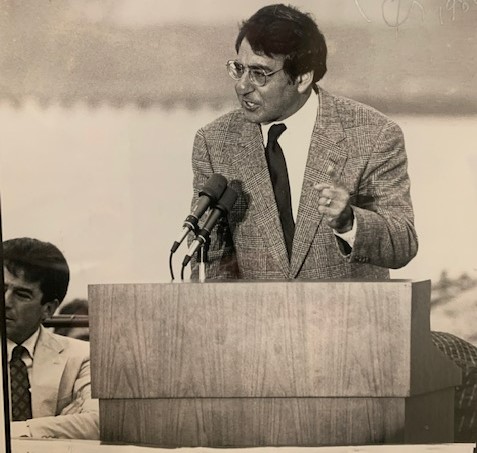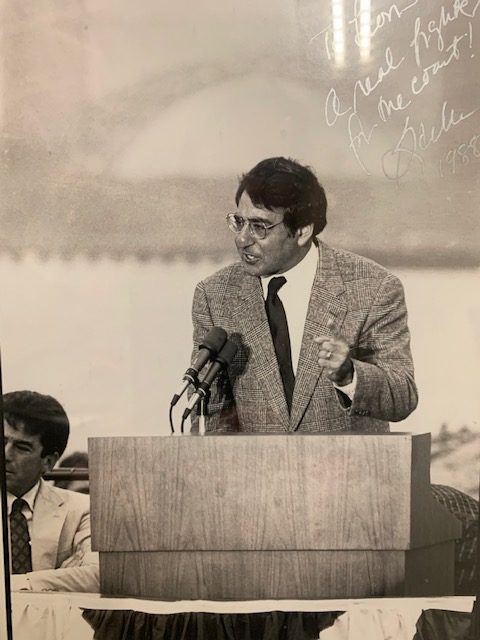
Sanctuary 30th Anniversary Series – Blog #10 “Finding sanctuary: The fight against offshore drilling” by Secretary Leon Panetta
This month, the Central Coast of California will celebrate the 30th anniversary of the creation of the Monterey Bay National Marine Sanctuary. The sanctuary is a tribute to democracy in action. Every part of our community – conservation, marine research, business, fishing, agriculture, tourism, hospitality, community and political leaders, recreation, education and concerned citizens – pulled together to save a national treasure.
When it was threatened by off-shore oil drilling, the community made clear it would not happen on our watch. It took dedication, commitment, patience and the will to fight and never stop fighting until the beauty of our Monterey Bay was protected not just for ourselves but for future generations to come. This is the story of that fight.
A national treasure
Those of us who were born and raised on the Central Coast know first-hand the
unique beauty of our ocean and coastline. As a young boy, my grandfather –- my Nono in Italian – would walk me from Van Buren Street to Fisherman’s wharf each day. He had spent a good part of his life at sea – on the great sailing ships at the turn of the century. He loved the ocean and shared that love with me. Monterey Bay at that time was a bustling harbor.
The sardine industry was at its pinnacle and Cannery Row was working around the clock. Italian families were very much a part of that history, working hard on fishing boats packed with sardines and in the canneries. But in the late 1940s, the sardine industry collapsed.
Farallon Islands. When threatened, we will fight back … and we did.
The threat
We were aware that a severe oil spill could damage the sensitive wildlife and coastline of California. It happened with the Santa Barbara spill in 1969 that spewed an estimated 3 million gallons of crude oil into the ocean, creating an oil slick 35 miles long along California’s coast and killing thousands of birds, fish and sea mammals.
In 1965, the Monterey County Board of Supervisors made a decision that seems unimaginable today: they approved a plan put forward by Humble Oil to build a major refinery on the coast at Moss Landing. It took a concentrated campaign by environmentalists, farmers and local residents to defeat Humble’s plan and set a standard for how to wage war to preserve natural spaces and resources.
When I was elected to Congress in 1976, it was clear to me that protecting the Monterey Bay came with the job. It was frankly unimaginable that anyone would be stupid enough to put the natural beauty of our area at risk.
Sell to highest bidder
But, James Watt the new Secretary of the Interior, decided to do just that. In 1981, he proposed that the entire shoreline off the continental United States be put up for sale to the highest bidder for oil drilling. Most of us in the California delegation, both Republican and Democrat, were strongly opposed.
It was clear the opposition had to be bipartisan. I went to a friend and colleague, Don Clausen, a Republican representing the Mendocino coast and asked him to join me in meeting with Secretary Watt.
The meeting was set in Clausen’s office. On the walls of his office were scenic photographs of the Mendocino coastline. With that backdrop, we argued that there were certain unique coastlines such as Big Sur and Mendocino that were national treasures.
And just like Yosemite and Yellowstone, they should be protected from oil drilling. As we were talking, Secretary Watt stood up and walked over to one of the photographs and pointed to an area near the crashing waves and with a smile said, “This would be a great place for a drilling rig.” Both Don and I realized that we were in deep trouble.
Drilling moratorium
Realizing that the secretary was not interested in making any exceptions to his blanket policy of off-shore drilling, we drafted an amendment that would stop the Administration from using any funds to advance their plan. The “moratorium amendment” would be added to the annual Interior Appropriations bill.
Although the Chairman of the Interior Subcommittee, Sidney Yates of Chicago, was supportive, that was not true for all the members of his subcommittee. We set up a war room in my office to lobby for support. It was not easy. We were facing opposition from oil companies. But we built a strong coalition of coastal representatives from Washington and Oregon to New England and the Carolinas to Florida.
We argued with non-coastal members that we all had a responsibility to protect national treasures for the sake of the nation wherever they were located. It worked. The amendment passed the Subcommittee, the full Committee and the Senate. And it continued to pass for 20 years.
But it was also clear that the “moratorium” was vulnerable to a gas crisis similar to what we are experiencing today and would eventually lose support. The focus had to be on establishing permanent protection and that is what led to the successful effort to create the Monterey Bay National Marine Sanctuary. Part II will tell that story.
 Leon E. Panetta is Co-Chair of the Monterey Bay National Marine Sanctuary Foundation Board of Directors. He founded the Panetta Institute at Cal State Monterey Bay. He served as U.S. secretary of Defense, director of the CIA, White House chief of staff, director of the Office of Management and Budget, and as a member of Congress from California’s Central Coast for 16 years. For more on the sanctuary’s 30th anniversary, go to montereybayfoundation.org.
Leon E. Panetta is Co-Chair of the Monterey Bay National Marine Sanctuary Foundation Board of Directors. He founded the Panetta Institute at Cal State Monterey Bay. He served as U.S. secretary of Defense, director of the CIA, White House chief of staff, director of the Office of Management and Budget, and as a member of Congress from California’s Central Coast for 16 years. For more on the sanctuary’s 30th anniversary, go to montereybayfoundation.org.
If you go
Monterey Bay National Marine Sanctuary Foundation is hosting the Sea Stars Gala from 5-10 p.m. Sept. 17 at the Cocoanut Grove Ballroom of the Santa Cruz Beach Boardwalk, 400 Beach St., Santa Cruz. For information, visit montereybayfoundation.org. On Sept. 18, Monterey Bay National Marine Sanctuary is hosting Sanctuary Fest along the Santa Cruz Wharf, Cowell Beach, and at the Sanctuary Exploration Center. For information, visit montereybay.noaa.gov.

